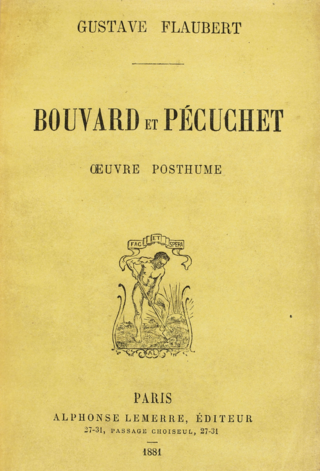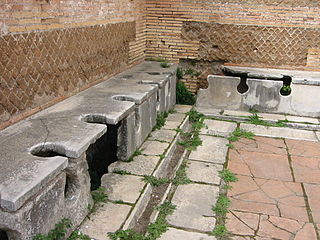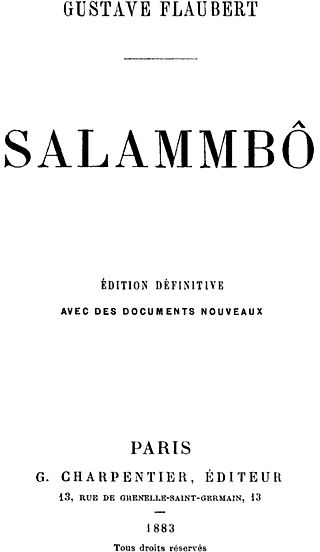
Anthony the Great was a Christian monk from Egypt, revered since his death as a saint. He is distinguished from other saints named Anthony, such as Anthony of Padua, by various epithets: Anthony of Egypt, Anthony the Abbot, Anthony of the Desert, Anthony the Anchorite, Anthony the Hermit, and Anthony of Thebes. For his importance among the Desert Fathers and to all later Christian monasticism, he is also known as the Father of All Monks. His feast day is celebrated on 17 January among the Eastern Orthodox and Catholic churches and on Tobi 22 in the Coptic calendar.

Gustave Flaubert was a French novelist. He has been considered the leading exponent of literary realism in his country and abroad. According to the literary theorist Kornelije Kvas, "in Flaubert, realism strives for formal perfection, so the presentation of reality tends to be neutral, emphasizing the values and importance of style as an objective method of presenting reality". He is known especially for his debut novel Madame Bovary (1857), his Correspondence, and his scrupulous devotion to his style and aesthetics. The celebrated short story writer Guy de Maupassant was a protégé of Flaubert.

Hieronymus Bosch was a Dutch painter from Brabant. He is one of the most notable representatives of the Early Netherlandish painting school. His work, generally oil on oak wood, mainly contains fantastic illustrations of religious concepts and narratives. Within his lifetime, his work was collected in the Netherlands, Austria, and Spain, and widely copied, especially his macabre and nightmarish depictions of hell.

Hilarion the Great (291–371) was an anchorite who spent most of his life in the desert according to the example of Anthony the Great (c. 251–356). While Anthony is considered to have established Christian monasticism in the Egyptian Desert, Hilarion is considered by his biographer Jerome to be the founder of Palestinian monasticism and venerated as a saint exemplifying monastic virtues by the Orthodox and the Roman Catholic Church.

Bouvard et Pécuchet is an unfinished satirical novel by Gustave Flaubert, published in 1881 after his death in 1880.
Three Tales is a work by Gustave Flaubert that was originally published in French in 1877. It consists of the short stories: "A Simple Heart", "Saint Julian the Hospitalier", and "Hérodias".

Crepitus is an alleged Roman god of flatulence created by Christians and used in their literature frequently as a fascinating subject to them. It is unlikely that Crepitus was ever actually worshipped. The only ancient source for the claim that such a god was ever worshipped comes from Christian satire. The name Crepitus standing alone would be an inadequate and unlikely name for such a god in Latin. The god appears, however, in a number of important works of French literature.

Salammbô (1862) is a historical novel by Gustave Flaubert. It is set in Carthage immediately before and during the Mercenary Revolt. Flaubert's principal source was Book I of the Histories, written by the Greek historian Polybius. The novel was enormously popular when first published and jumpstarted a renewed interest in the history of the Roman Republic's conflict with the North African Phoenician outpost of Carthage.

Matthew 4:1 is the first verse of the fourth chapter of the Gospel of Matthew in the New Testament. This verse opens the section in Matthew dealing with the temptation of Christ by Satan. Jesus has just been baptized by John the Baptist; in this verse he is led out into the wilderness.

The Temptation of Saint Anthony is an often-repeated subject in the history of art and literature, concerning the supernatural temptation reportedly faced by Saint Anthony the Great during his sojourn in the Egyptian desert. Anthony's temptation is first discussed by Athanasius of Alexandria, Anthony's contemporary, and from then became a popular theme in Western culture.

The temptation of Christ is a biblical narrative detailed in the gospels of Matthew, Mark, and Luke. After being baptized by John the Baptist, Jesus was tempted by the devil after 40 days and nights of fasting in the Judaean Desert. At the time, Satan came to Jesus and tried to tempt him. Jesus having refused each temptation, Satan then departed and Jesus returned to Galilee to begin his ministry. During this entire time of spiritual battle, Jesus was fasting.

Paul et Virginie is a novel by Jacques-Henri Bernardin de Saint-Pierre, first published in 1788. The novel's title characters are friends since birth who fall in love. The story is set on the island of Mauritius under French rule, then named Île de France. Written on the eve of the French Revolution, the novel is recognized as perhaps Bernardin's finest work. It records the fate of a child of nature corrupted by the artificial sentimentality of the French upper classes in the late eighteenth century. Bernardin de Saint-Pierre lived on the island for a time and based part of the novel on a shipwreck he witnessed there.
Kuchuk Hanem was a famed beauty and Ghawazee dancer of Esna, mentioned in two unrelated accounts of travel to Egypt, the French novelist Gustave Flaubert and the American adventurer George William Curtis.

Jan van de Venne or Jan van der Venne, also known as Pseudo van de Venne, was a Flemish painter of genre, religious scenes, and cabinets who was court painter to the governors of the Southern Netherlands. Many of his works depict "low-life" genre scenes of tooth-pullers, card-players and hurdy-gurdy players, tronies and expressive religious scenes.

St. Thaïs, of fourth-century Roman Alexandria and of the Egyptian desert, was a repentant courtesan.
The Temptation of St. Anthony is an opera rooted in the gospel tradition based on the novel The Temptation of Saint Anthony by Gustave Flaubert, directed by Robert Wilson with book, libretto and music by Bernice Johnson Reagon and costumes by Geoffrey Holder. The production debuted in June 2003 as part of the Ruhrtriennale festival in Duisburg Germany with Carl Hancock Rux as Saint Anthony and Helga Davis as Helarion. Subsequent performances included the Greek Theater in Siracusa, Italy; the Festival di Peralada in Peralada, Spain; the Palacio de Festivales de Cantabria in Santander, Spain; and Sadler's Wells in London, Great Britain; the Teatro Piccinni in Bari, Italy; the Het Muziektheater in Amsterdam, Netherlands; the Teatro Arriaga in Bilbao and the Teatro Espanol in Madrid, Spain. The opera made its American premiere at the Brooklyn Academy of Music's BAM Next Wave Festival in October 2004. The official "world premiere" was held at the Paris Opera Garnier becoming the first all African American opera to perform on its stage since the inauguration of the Académie Nationale de Musique - Théâtre de l'Opéra in 1875.

The Temptation of Saint Anthony is an 1898 French silent trick film by Georges Méliès. The film, featuring Méliès and his frequent collaborator Jehanne d'Alcy, is a version of the traditional artistic subject of the temptation of Saint Anthony, showing Anthony the Great's faith and chastity tested by visions.

The Temptation of St. Anthony is a painting by Spanish surrealist artist Salvador Dalí. Painted in 1946, it is a precursor to the body of Dalí's work commonly known as the "classical period" or the "Dalí Renaissance".

Antoine Marie Jules Sénard was a French lawyer and politician who was briefly President of the Constituent Assembly of the French Second Republic. After returning to private practice during the Second French Empire he successfully defended Gustave Flaubert in an action against his Madame Bovary.
Georges de Saint-Foix was a French musicologist, connoisseur of Mozart and specialist of the 19th century and the beginning of the 20th century.
















